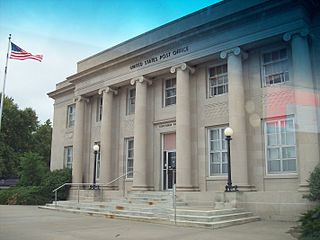
Pope Miltiades, also known as Melchiades the African, was the bishop of Rome from 311 to his death on 10 or 11 January 314. It was during his pontificate that Emperor Constantine the Great issued the Edict of Milan (313), giving Christianity legal status within the Roman Empire. The pope also received the palace of Empress Fausta where the Lateran Palace, the papal seat and residence of the papal administration, would be built. At the Lateran Council, during the schism with the Church of Carthage, Miltiades condemned the rebaptism of apostatised bishops and priests, a teaching of Donatus Magnus.

St. Donatus is a city in Jackson County, Iowa, United States. The population was 120 at the time of the 2020 census. St. Donatus is known for its status as a Luxembourger village, with historic architecture and views along U.S. Route 52. It is the home of a historic Catholic church, which is dedicated to Saint Donatus of Muenstereifel, the town's namesake. It was formerly named Tete Des Morts, which is the name of a creek that flows through the village.

Concordia is a city in and the county seat of Cloud County, Kansas, United States. It is located along the Republican River in the Smoky Hills region of the Great Plains in North Central Kansas. As of the 2020 census, the population of the city was 5,111. Concordia is home of the Cloud County Community College and the Nazareth Convent and Academy.

Donatism was a Christian sect leading to a schism in the Church, in the region of the Church of Carthage, from the fourth to the sixth centuries. Donatists argued that Christian clergy must be faultless for their ministry to be effective and their prayers and sacraments to be valid. Donatism had its roots in the long-established Christian community of the Roman province Africa Proconsularis and Mauretania Tingitana, in the persecutions of Christians under Diocletian. Named after the Berber Christian bishop Donatus Magnus, Donatism flourished during the fourth and fifth centuries. Donatism mainly spread among the indigenous Berber population, and Donatists were able to blend Christianity with many of the Berber local customs.

February 16 - Eastern Orthodox liturgical calendar - February 18

Donatus of Fiesole was an Irish teacher and poet, and Bishop of Fiesole.
Andrew the Scot was the Irish-born student and assistant of St. Donatus. He served as archdeacon of Fiesole under Bishop Donatus.
This page is an index of lists of people considered martyrs. A martyr is someone who suffers persecution and death for advocating, renouncing, refusing to renounce, or refusing to advocate a belief or cause as demanded by an external party. This refusal to comply with the presented demands results in the punishment or execution of the martyr by the oppressor.
Saint Romulus may refer to:
Secundian or Secundianus may refer to:

Saint Romulus of Fiesole is venerated as the patron saint of Fiesole, Italy. Romulus was probably a local deacon, priest, or bishop of the 1st century.

Saint Donatus, also called Donato of Zara, was a Dalmatian saint who became a bishop and a diplomat for the Dalmatian city-state of Zadar (Zara). His feast day is celebrated on 25 February.

Saint Donatus of Arezzo is the patron saint of Arezzo, and considered a bishop of the city.

Donatus of Muenstereifel is a catacomb saint whose relics are found in the Jesuit church in Bad Muenstereifel. He is widely venerated in the Rhine valley region of Germany and the Low Countries, and he is a patron saint of Buda and of protection against lightning. His relics were translated to Muenster Eifel in the 17th century from the Catacombs of Rome, where he had been originally buried.
Lutheranism is a major branch of Protestantism, identifying primarily with the theology of Martin Luther, the 16th-century German monk and reformer whose efforts to reform the theology and practices of the Catholic Church launched the Protestant Reformation.
Saint Donatus of Euroea was a Greek saint, who is revered in both by both Eastern Orthodox and Roman Catholics, mostly in Albania and Greece.
Romulus was one of the mythical founders of Rome. Romulus may also refer to:
St. Bridget of Fiesole is an Irish Saint whose festival is celebrated in Italy on 1 February.
The Diocesan Seminary of Fiesole is a former Roman Catholic seminary in Fiesole, Italy. Founded in the 17th century, the seminary was run by the Diocese of Fiesole until it was closed in 1970. Today, the seminary retains several pieces of historically significant art and library collections.
This page is based on this
Wikipedia article Text is available under the
CC BY-SA 4.0 license; additional terms may apply.
Images, videos and audio are available under their respective licenses.










